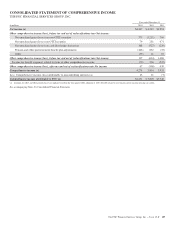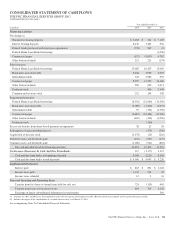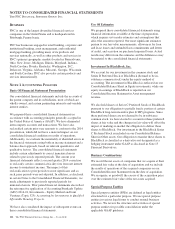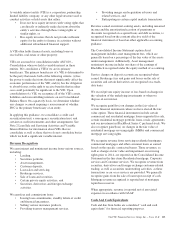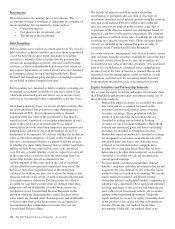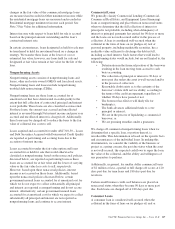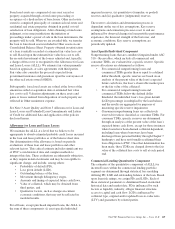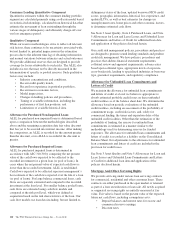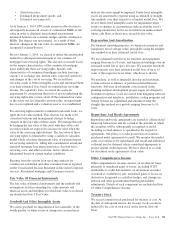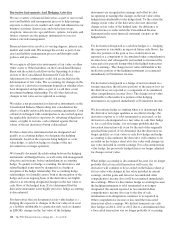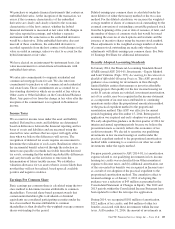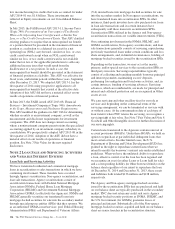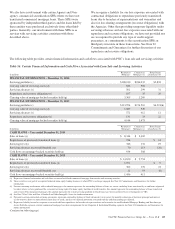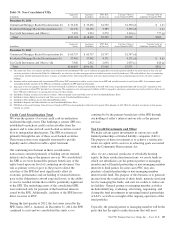PNC Bank 2014 Annual Report Download - page 135
Download and view the complete annual report
Please find page 135 of the 2014 PNC Bank annual report below. You can navigate through the pages in the report by either clicking on the pages listed below, or by using the keyword search tool below to find specific information within the annual report.
changes in the fair value of the commercial mortgage loans
are measured and recorded in Other noninterest income while
the residential mortgage loans are measured and recorded in
Residential mortgage noninterest income each period. See
Note 7 Fair Value for additional information.
Interest income with respect to loans held for sale is accrued
based on the principal amount outstanding and the loan’s
contractual interest rate.
In certain circumstances, loans designated as held for sale may
be transferred to held for investment based on a change in
strategy. We transfer these loans at the lower of cost or
estimated fair value; however, any loans held for sale and
designated at fair value remain at fair value for the life of the
loan.
Nonperforming Assets
Nonperforming assets consists of nonperforming loans and
leases, other real estate owned (OREO) and foreclosed assets.
Nonperforming loans and leases include nonperforming
troubled debt restructurings (TDRs).
Nonperforming loans are those loans accounted for at
amortized cost that have deteriorated in credit quality to the
extent that full collection of contractual principal and interest
is not probable. These loans are also classified as nonaccrual.
For these loans, the current year accrued and uncollected
interest is reversed through Net interest income and prior year
accrued and uncollected interest is charged-off. Additionally,
these loans may be charged-off to reduce the basis to the fair
value of collateral less costs to sell.
Loans acquired and accounted for under ASC 310-30 – Loans
and Debt Securities Acquired with Deteriorated Credit Quality
are reported as performing and accruing loans due to the
accretion of interest income.
Loans accounted for under the fair value option and loans
accounted for as held for sale that would otherwise be
classified as nonperforming, based on the nonaccrual policies
discussed below, are reported as performing loans as these
loans are accounted for at fair value and the lower of carrying
value or the fair value less costs to sell, respectively.
However, based upon these nonaccrual policies, interest
income is not accrued on those loans. Additionally, based
upon the nonaccrual policies discussed below, certain
government insured loans accounted for at amortized cost for
which we do not expect to collect substantially all principal
and interest are reported as nonperforming and do not accrue
interest. Alternatively, certain government insured loans
accounted for at amortized cost for which we expect to collect
substantially all principal and interest are not reported as
nonperforming loans and continue to accrue interest.
Commercial Loans
We generally classify Commercial Lending (Commercial,
Commercial Real Estate, and Equipment Lease Financing)
loans as nonperforming and place them on nonaccrual status
when we determine that the full collection of interest or
principal is not probable, including when delinquency of
interest or principal payments has existed for 90 days or more
and the loans are not well-secured and/or in the process of
collection. A loan is considered well-secured when the
collateral in the form of liens on (or pledges of) real or
personal property, including marketable securities, has a
realizable value sufficient to discharge the debt in full,
including accrued interest. Such factors that would lead to
nonperforming status would include, but are not limited to, the
following:
• Deterioration in the financial position of the borrower
resulting in the loan moving from accrual to cash
basis accounting;
• The collection of principal or interest is 90 days or
more past due unless the asset is well-secured and/or
in the process of collection;
• Reasonable doubt exists as to the certainty of the
borrower’s future debt service ability, according to
the terms of the credit arrangement, regardless of
whether 90 days have passed or not;
• The borrower has filed or will likely file for
bankruptcy;
• The bank advances additional funds to cover
principal or interest;
• We are in the process of liquidating a commercial
borrower; or
• We are pursuing remedies under a guarantee.
We charge off commercial nonperforming loans when we
determine that a specific loan, or portion thereof, is
uncollectible. This determination is based on the specific facts
and circumstances of the individual loans. In making this
determination, we consider the viability of the business or
project as a going concern, the past due status when the asset
is not well-secured, the expected cash flows to repay the loan,
the value of the collateral, and the ability and willingness of
any guarantors to perform.
Additionally, in general, for smaller dollar commercial loans
of $1 million or less, a partial or full charge-off occurs at 120
days past due for term loans and 180 days past due for
revolvers.
Certain small business credit card balances are placed on
nonaccrual status when they become 90 days or more past
due. Such loans are charged-off at 180 days past due.
Consumer Loans
A consumer loan is considered well-secured when the
collateral in the form of liens on (or pledges of) real or
The PNC Financial Services Group, Inc. – Form 10-K 117


